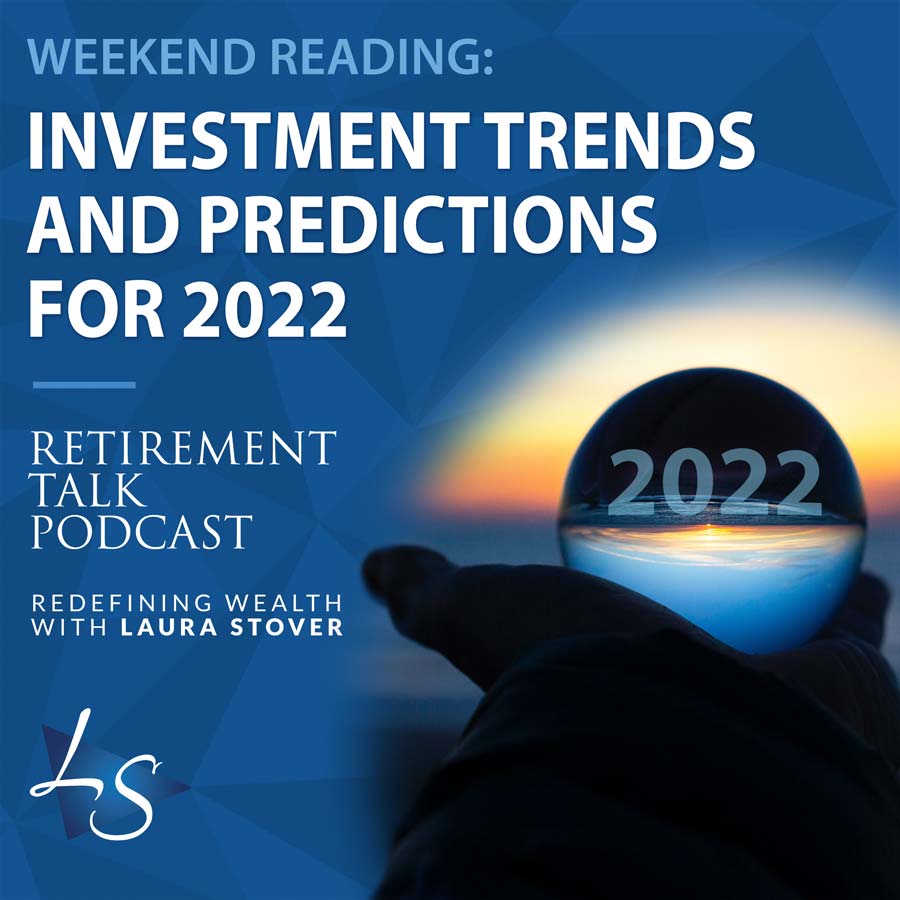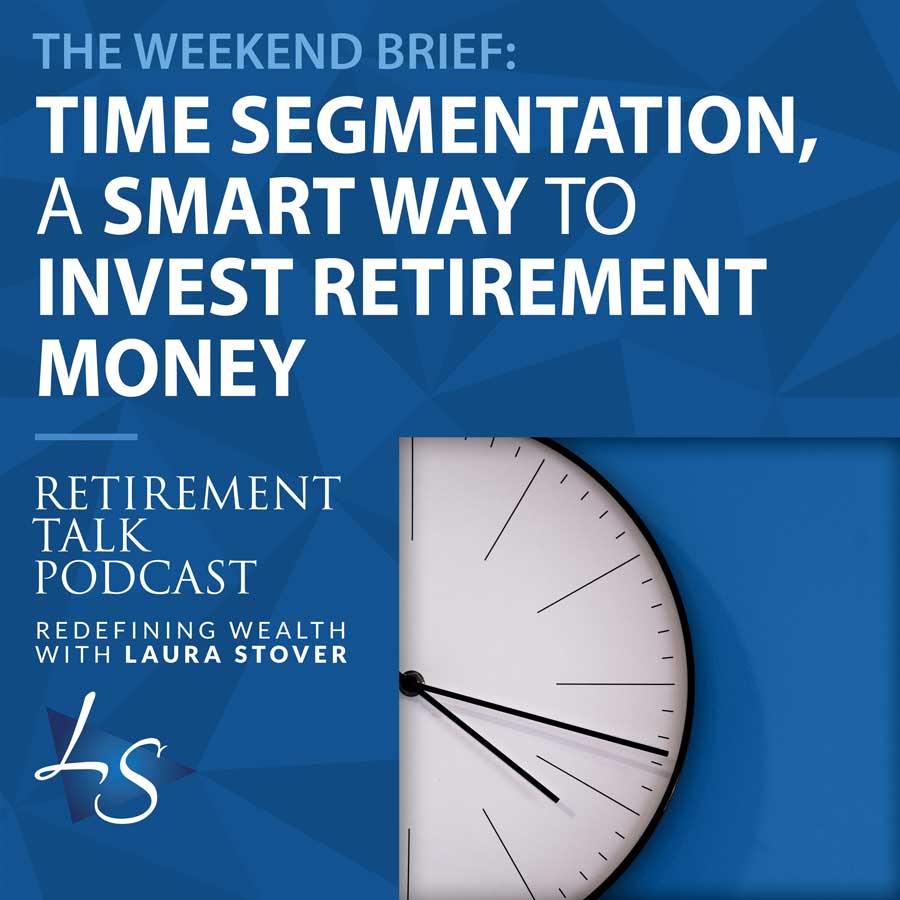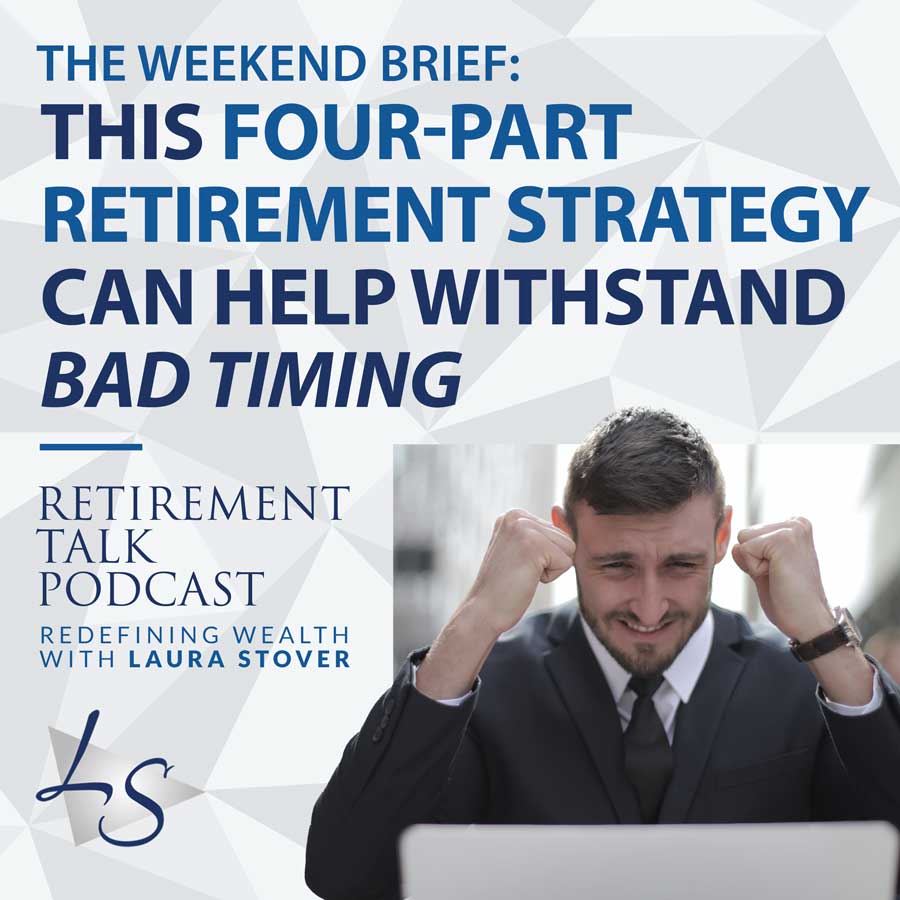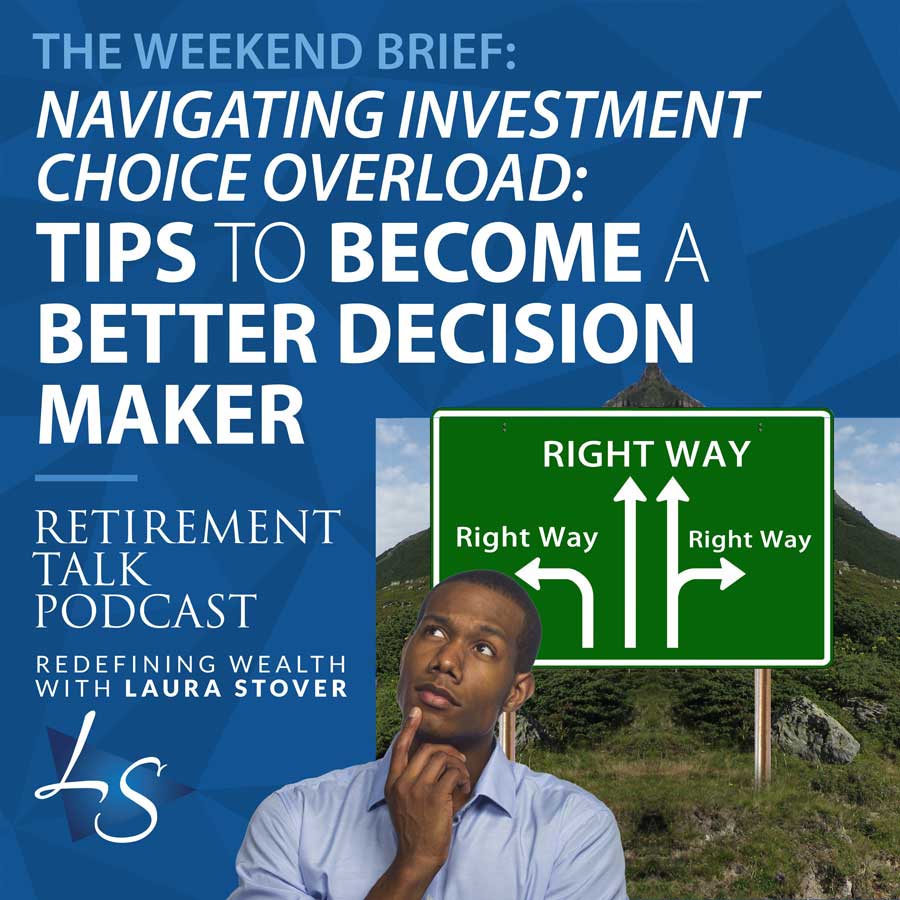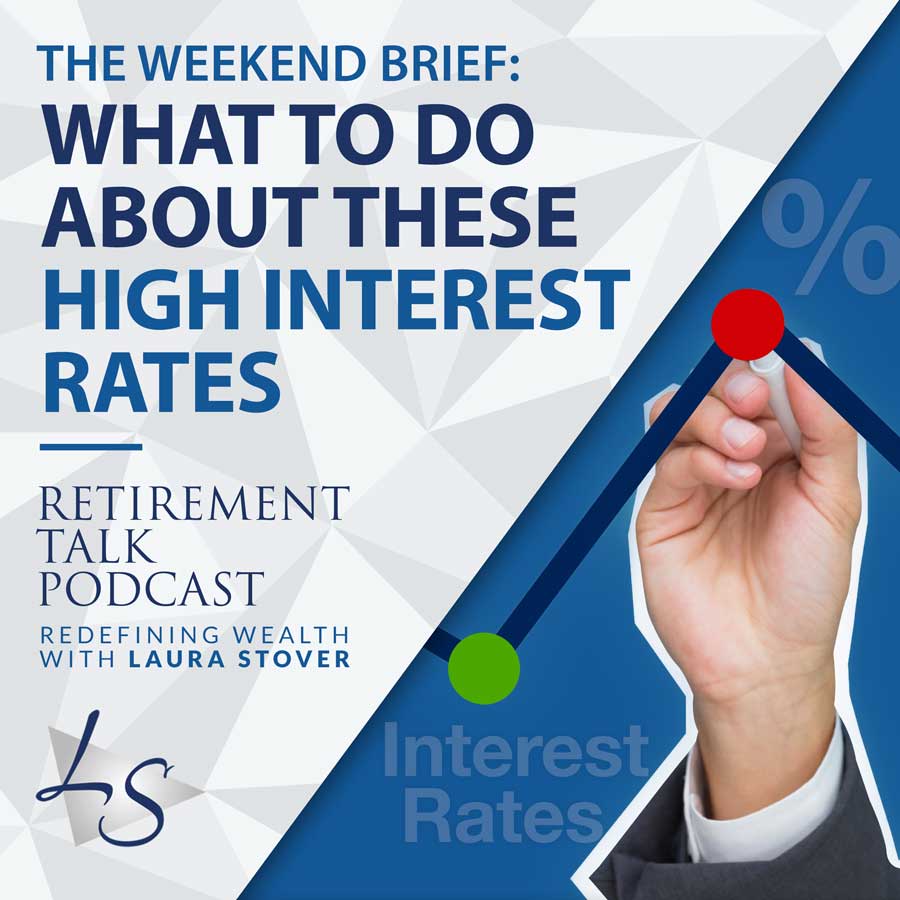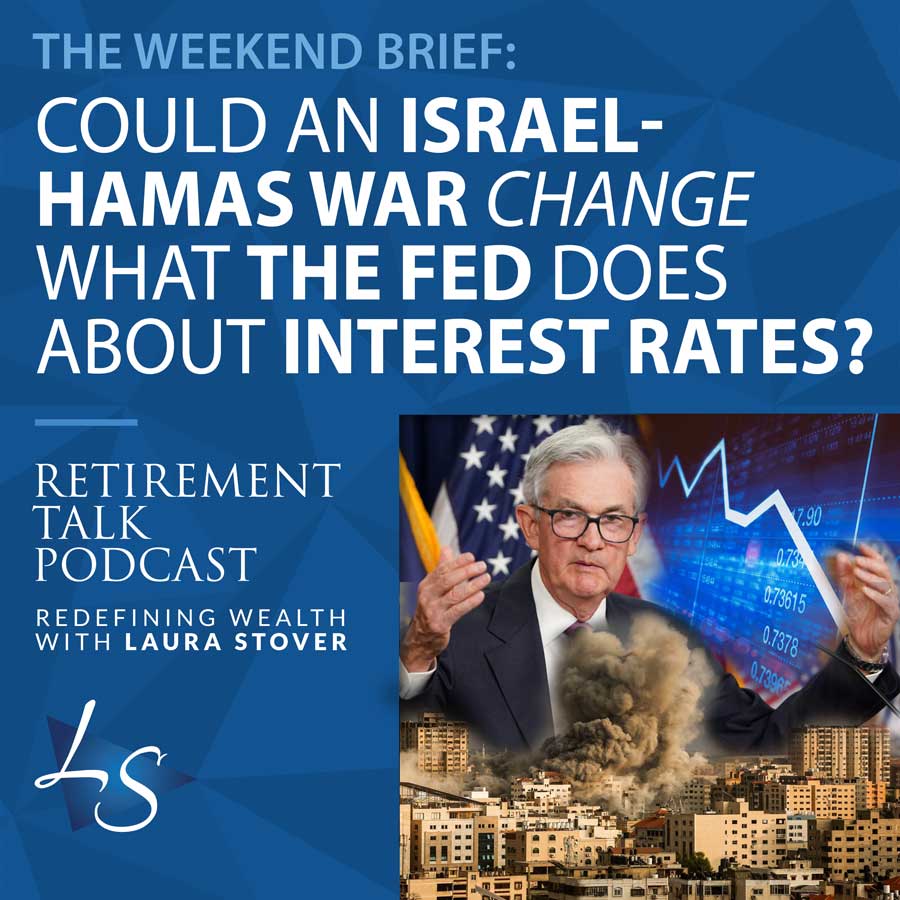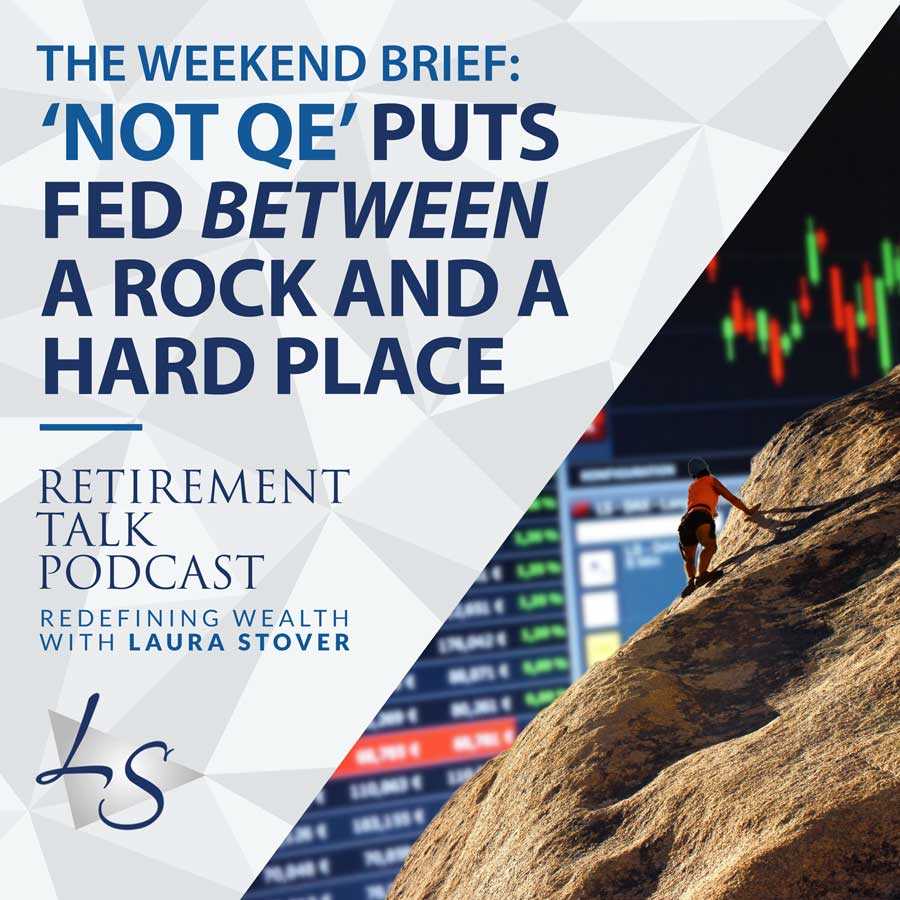As we are settling into the new year, a lot of economic movement is already happening. The markets are off to a rocky start. We were probably a little spoiled in 2021, especially with the S&P ending the year a little over 28%. Now we are going through an adjustment period. So, what can investors expect in 2022? As a result of supply chain shortages and subsequent inflation, we’ll probably be seeing higher interest rates.
Inflation is going to get worse before it gets better. Furthermore, COVID could still play a big impact on investments in the new year. We just don’t know what the future holds. Managing volatility will be crucial to your long-term retirement success. On today’s episode, we’ll take a deep dive into the investment outlook for 2022 and what you can do to keep your retirement plan on track.
Review the article mentioned in today’s show >>
Rate & Review the Podcast:
https://podcasts.apple.com/us/podcast/retirement-talk-podcast-with-laura-stover/id571347188
LINKS
Schedule a Review: https://redefiningwealth.info/schedule/
TIMESTAMPS (SHOW NOTES)
2:34 – The fed chair has made some new announcements
5:40 – What interest rate hikes will we see in 2022?
9:06 – Purchases made by the central bank
11:29 – The S&P has doubled since 2020
13:00 – Is the market due for a correction?
15:23 – Being hedged in our portfolios
16:36 – Who pays the annual interest charge on the national debt?
18:24 – Will the markets calm down at the end of the month?
21:12 – What investment trends should we look out for?
22:52 – Stocks do well when the fed keeps rates low
25:30 – Inflation is going to get worse before it gets better
28:08 – Should people invest in big tech in 2022?
32:50 – What can we expect with midterm elections?
35:16 – Don’t be a spectator, have a plan!
Listen & Subscribe
Review the Transcript:
Ron Stutz: Welcome to Retirement Talk, the redefining wealth shift. Your source for financial information for pre-retirees and retire. We’re here to help you better navigate during these economic times. We’re here to discuss thoughts and ideas in the field of finance and retirement, as well as discuss trending topics and the impact of major legislation that could impact your retirement, we’ll break it all down. These discussions can help you make better informed decisions so you can live the lifestyle imagine and make better financial choices.
Laura Stover is a registered financial consultant and CEO of LS Wealth Management, as well as founder and owner of LS Tax, a consulting firm. She’s been featured in Forbes, CNBC and The Wall Street Journal. I’m Ron Stutz, our topic for today is from Forbes, The Best Investing Trends for 2022. Now here is your host, Laura Stover.
Laura Stover: Hello, hello, hello, Ron. How are you? And happy new year.
Ron Stutz: It is great to be with you here at the beginning of a brand new year.
Laura Stover: New? Some things will be new and some things may continue on.
Ron Stutz: Exactly. Laura we’re just in the new year and already so much is happening. After closing out a very nice year, the markets are off to a rocky start. It’s been up and down, back and forth. What can investors expect here in 2022?
Laura Stover: Well, that’s sort of what I alluded to probably a little bit of this, that and everything. But yes, indeed, the first couple of weeks of the new trading year seem to, I think always are a little volatile and they have very little direction. And it’s primarily, there’s one key person that we’re going to spend a little time talking about the Fed. And as we record today’s show, he’s actually in his confirmation hearing today to continue on. I suspect he will be reconfirmed. No new news there.
But also some of this volatility is primarily caused by fund managers, institutions, hedge funds. They’re readjusting their portfolios for the new year, but really the catalysts that we thank for our new year’s bumpy ride thus far is really some uncertainty. Some things that we know are forthcoming with Fed policy.
Ron Stutz: Well, the Fed chair has already made several announcements. And Laura, talk about some of those, if you would.
Laura Stover: Well, obviously January 5th, we saw some market pullback, the 10th just recently we saw some pullback. Every other day, it’s a little bouncy, but some good news here. The S&P, it’s only down about 4%, and yes, it’s some of this uncertainty regarding what the Fed’s going to do in anticipation of raising interest rates. That makes the market a bit bumpy. And we’re likely going to see this begin from what we know thus far, starting in March and ending by June with tapering as well with the bond purchases, which will discuss a little bit more here.
But growth stocks in particular, the tech sector, these have been bouncy. But if we look back at 2021 run, the S&P ended the year was actually up a little over 28%. We had like 70 all time highs in ’21, so people are a little spoiled. It’s like getting really good results in the gym and you slack off for a week or two. Now we’re going through some adjustments and getting used to the new year. Very focused on my goals this year, the gym, gym, gym.
And so we look at the huge volatility primarily around FANG stocks. Remember that word from a few years ago? Companies like Apple, Microsoft Alphabet. They surged last year, respectfully 65, 52, 35% returns. That spoils people a little bit, and it makes up a good percentage of the market cap. So unemployment is at about 15%, now, granted, this is the great error of resignations, no jabs, no jobs. I hear all kinds of things out there going on.
But when that rate is at, and we are seeing a slowing GDP at only 2%, and then this big surge with the Omicron cases, we’re still peaking here early to mid-January in terms of cases. My area, a very hot seat, don’t come to the Northwest area right now. It’s this way across the country, and so I think we’re going to see a little volatility for a little longer, but nothing to get too upset over, nothing to be radically concerned with in my view.
But keeping an eye on the Fed lowering interest rates. He did this in an attempt to stimulate consumer demand, and they’ve been low for very long. Go back to Greenspan in 2001, we have been in a low interest rate environment for almost two decades now.
Ron Stutz: Yeah. There are a couple of layers to all this, and they would begin to unwind some of the largest and most unprecedented market intervention in the history of our country in the wake of the pandemic. They started in November actually, started tapering bond purchases and increments. That’s the plan in the amount of $15 billion a month, a reduction from the previous $120 billion a month they were previously buying.
They also announced they would keep interest rates at zero. We know now, however, there will likely be maybe two, maybe three interest rate hikes starting in March of this year.
Laura Stover: That’s the news thus far, and then ending sometime in June. And how is this going to affect retirees, pre-retirees? Well, if you’ve been a conservative investor, if you’ve been geared in fixed income, you’re seeing durations on some of these longer term bonds because they have an inverse relationship with interest rates. And when an interest rate goes up, a bond value goes down. So we’re seeing some of that, 2021 was not a good year for bonds in general.
But they have to try to reduce inflation. Now, this is what is top of mind, we’re seeing some shortages. My sister texted me last night, our local stores are out of toilet paper again. I don’t know that this is going to be a rampant shortage on toilet paper again, but we definitely see shortages on certain types of products right now. They’re not suspecting this supply chain thing to be resolved until the end of the year. It’s still causing some significant problems.
But inflation is continuing to peak, and this is part of the market reacting to those interest rates being raised. Then it only becomes more of an expense to the consumer. It slows the curve of growth in the economy in general. So listeners to the show, investments with rising interest rates, that does affect markets. And it really depends on what stage of life you’re in, where you’re at in that stage.
I recently, Ron had a review with a client, a prospective client. She had a sizable nest egg. She’s done very well, but I warned her that her current allocations are very tech-heavy. Now we did a five-year analysis and we do a stress test. Her draw down over the last five years with previous market corrections was over 30%.
Ron Stutz: Wow.
Laura Stover: Too much risk. So the question becomes, it’s a good time to really look at your portfolio, do you need to take the amount of risk that you are subject to? Oftentimes people don’t even realize the amount of risk they’re subject to. Most people think bonds are safe, that is not always the case by any means. We’re seeing mild negative returns. It might be less than one per cent or 1%, but that’s still a negative rate, so we have to put it into perspective.
And the big takeaway in my view with discussions with folks having balance, I believe so strong having rules-based processes. You’ve got to have a plan to manage volatility. It’s different from just being conservative. Managing volatility is a crucial component to long term success.
Ron Stutz: Now, the Fed his take is this, inflation is all transitory and caused by the supply chain disruption that has contributed the big price increases in some parts of the economy. Now, since June of 2020, the central bank began purchasing $120 billion in bond purchases, $80 billion in treasuries and 40 billion in mortgage bank securities. Every month they did this to add liquidity and keep the financial system working efficiently, right?
Laura Stover: We know how to spend money, don’t we?
Ron Stutz: That’s for sure.
Laura Stover: And we’ve been doing this for some time. I’m hoping to have some very esteemed guests on the show this year to discuss our nation’s debt. Yes, we had to at certain points, prop up the economy with some of the quantitative easing that’s been done. But now in hindsight, was it really the right thing to shut everything down in 2020? I can’t really blame anyone. When you have a new Black Swan event, this is something we’ve never, no one’s ever seen before. You make the best judgments, I guess, at the time.
But who would’ve ever thought anything would occur that we were all trapped in our house? Some people are still there and two years in. And there’s a lot of fear out there with some people, other people, no, they’re going to do their thing. And I think they’re again, is balanced. So they did have to add liquidity, but this has substantially, the bigger picture it’s added to our debt substantially. Now we’re going to see an environment where these interest rates are going to start to rise.
And that’s only going to add to the debt and the bottom line, we don’t want to worry about having a crystal ball. We’ve had a robust extended bull market. You have to stay invested, not get scared, go to cash just based on emotion and try to market time. You do need, however, I believe a volatility buffer, build into your portfolio and overall plan around the income you’re going to need, because you don’t want to risk income. And you have to have a plan for keeping up with your expenses with inflation.
And that’s why I designed The Redefining Wealth Process so you can coordinate all that framework, especially if you’re nearing or already in retirement.
Ron Stutz: Oh, for sure. And there’s so much uncertainty, as you said, and certain things you need to keep in mind. The fact is, market declines of 10% or greater. We might call that market corrections occur roughly 0.5 times per year. That’s not a lot. Declines of 20% or greater, which we might refer to as a bear market occur on average about every seven years which is certainly not very often.
Laura Stover: Well, the market, the S&P’s doubled in value since 2020. Now, I wish I had a crystal ball last year right at that 34% low. March 23rd, 2020 was the bottom. Now, when you’re up to Zoom and know exactly what to purchase and have that forecast, it would make quite the difference. But in the last 19 months, the sell off to the tune of 10% is not uncommon. Typically, we just… Because of all of the liquidity, because of the infusion of money, we have not been in the typical type of market cycles that we normally see.
But every 19 months, a sell off of about 10% is common. In the 29 of the past 50 years, the S&P 500 experience, this type of market decline, it happens. A correction of 10% happens about every 19 months on average, going all the way back to 1928.
Ron Stutz: Wow. So in theory, for 2022, we’re due for a correction now.
Laura Stover: Interestingly enough, the S&P is only less than 1% below its most recent all time high from September of 21 and bounce back from a slump of about 5.2% earlier in the month last year. Now, that’s a very small pullback, especially when compared with the 14.2% average decline that has happened during the year since 1980. I wasn’t even out of high school then. Now, out some naysayers, such as Harry Dent, who I think his research is spot on in terms of cycles, demographics.
But he says, whether he is right or wrong, he said, “A lot that’s been wrong,” but he says, “There’s going to be a huge setback toward the end of this year.” I’d rather weigh in the side of caution to credible sources because I believe earnings are still very good for many companies, and we’re going to continue to see good returns. I don’t think it’s going to be typically as huge as what we’ve grown accustomed to maybe the last year or year and a half, two years, but I think we still have some good days ahead.
Again, no one has a crystal ball. We’re tapering with the eminent interest rate hikes, with the pandemic still lingering, high inflation and slower economic growth. We are going to see some bumpy days though.
Ron Stutz: And this pandemic just keeps going on and on and on. You’re so right about inflation and slow economic growth. Goldman Sachs said, “The first quarter GDP is only going to about 2%.”
Laura Stover: Yeah, and with that said, we may see a correction contained five to 8%. Any pullbacks probably I think would be in this range. We’ll see. I’m not trying to predict the future. I do a lot of research, one of those early morning people and do a lot of reading. This seems to be the consensus, maybe five to 8%. That’s going to feel kind of scary to people when it’s happening, because we’ve been in such a bull market.
But we have to understand this is normal. The market’s not guaranteed. Your plan needs to be guaranteed, but the market is not guaranteed.
Ron Stutz: Yeah, that’s for sure. No question about that. Now, you need something bad to happen, you mentioned to have a meaningful correction. The right planning you can hedge, you can segment assets and you can take a look in general the main risk. Is the Fed raising rates faster than they have to. For us, we’re about being hedged in your portfolio, right?.
Laura Stover: Yes, and that’s the philosophy, being hedged, and Powell did say, they’ll begin, reducing those purchases, 10 billion, five billion starting… No, they started this already November 21st, and they’re going to continue to do it in increments and adjust things based on the economic outlook. The Fed’s really been in a tough spot. They have to fight this inflation, they’re ending that bond purchase.
. They’re signaling, they’ll raise interest rates in March. I think it’s the right move. They are late to the decision. Quite a few opinions. Believe they’re a little late to the party. Fashionably late, but late indeed. I believe they have a little breathing room, but again, U.S. debt approaching 30 trillion and growing at two trillion a year. By 2030, on this project will be at 50 trillion.
Ron Stutz: Wow. Debt is a drag on future growth. Laura, who’s going to pay the 1% annual interest charge on all that incredible debt?
Laura Stover: I think Dan, our engineer said that he was up for donating. No, we are, all of us are. Dan Will. We’re all going to pay, our future generations are… Every one of us are going to pay. But we don’t really see it, it’s not coming like an invoice in the mail where people can really connect with the problems we have here. One of our managers, well, let me just back up a little, the U.S. government, if we’re taking in a trillion a year in tax revenue, 1% on 50 trillion, let me do some interesting math here. That’s 500 billion a year.
Half of current tax receipts, the math simply can’t work. I know a lot of managers believe this is going to be the period of what we call the great reset. The point in time, where we’re focused to deal with debt, the entitlement problems, ultimately higher taxes. Michael and I have been speaking of that on numerous past shows. Reduced pension benefits combined with debt monetization. That’s our future. I don’t mean to sound grim for 2022, but John Mauldin, he says by 2028.
I think it may be sooner if we have any other crisis. So we have this huge debt, we have to always have those emergency funds we talk out on an individual basis. So wonder if the United States has another Black Swan event or a crisis of any type. This could really start to become very concerning. We have no way of knowing, but I believe it’s very unavoidable.
Ron Stutz: Laura, so it’s been a bumpy start to the new year. But what you’re saying is, it should calm down by the end of the month.
Laura Stover: Well, I expect markets to sell off a bit more before we find a short term bottom in all the slop going on here the first part of the year. But investors should expect at least one 10% correction this year, that’s normal. After a big three years, it should not be a surprise. And 2020, we had that rapid sell off of 34% and equally rapid recovery. So doubling returns, we need to hedge portfolios.
That ability to go risk off speaks volumes because you’re preserving capital for the percentage returns to compound on when the market rebounds. I sit down, I go through simple analogies with clients on this all of the time. You have to have growth in the portfolio, it’s important to manage that volatility. Hedging is very, very important.
Ron Stutz: Bonds will be a very difficult place to make money this year when the Fed starts to raise rate, and that gives stocks a brighter outlook. Are you in agreement with all that, Laura?
Laura Stover: Yes. I still think bonds are going to be a little bit speculative though, because the treasury’s at all time highs. Like I said in ’21, because of the rise in interest rates, that’s an inverse relationship with bond. So everybody was ready for a booming economic recovery in 2021 all made possible by the COVID vaccines. Now, some were saying the end of the pandemic was in sight. I wish that was the truth.
I was hopeful there for a while too, then Delta is turning into a dominant strain Omicron now. 2021 drew to a close, the uptick is peaking with infections. The virus is surging, the pandemic is generating a mixed signal, one after another greatly complicating the global economic recovery.
Ron Stutz: An area meaning investors don’t distinguish is the fact that the market and the eco are really two separate entities.
Laura Stover: That’s very true. And I think, Ron, at the most basic level, the economy is the… Look at it this way, it’s the production and consumption of goods in services. So encompasses all individuals, companies and the government. The stock market, however, is an exchange where the buying, the selling and the issuance of shares and publicly held companies take place. That’s our economic lesson here on the show today.
So yes, two different entities. So one can do poor, one can do well. They don’t necessarily have to be correlated.
Ron Stutz: There are signs tempered by other indications that investors still have money to make in 2022. What about the in investing trends to watch out for in the new year, Laura?
Laura Stover: Markets are still being driven by the COVID-19 pandemic. Now, which way will this go? There’s hope that 2022 is the year with normalcy. Highlight that word, Ron, say normal. Is anything normal anymore.
Ron Stutz: Not really.
Laura Stover: Sending travel, commercial, real estate, tradition retail stocks higher, but then again, we’ve heard the story before the Delta virus wreaked havoc in ’21. And as the calendar turned, now Omicron’s emergence offers some short-term and long-term worries. And even if this variant doesn’t produce an indefinite amount of surges, we’re seeing right now in deadly infections, what is the next variant around the corner? I’m going out on a limb. I have a trip planned, I was just invited yesterday to New York City Times Square for an interview on the set in the middle of New York City. So I’m hoping by mid-June. I can’t take it anymore. Two years is long enough.
Ron Stutz: It is.
Laura Stover: I’m going to go for it. We have to live, we can’t just stay in fear indefinitely. And I think have to be smart. I’m not advocating one way or another, will stay neutral on what the right choice is for people as an individual, but wear your mask out in public, wash, keep some distance. These things do help.
Ron Stutz: Yeah. The way I look at it, you have to do everything you can to stay safe and stay healthy. Basically what you’re saying is mother nature, not humans gets write the end of the story. And principally, investors should realize that the post COVID market rally is already here, even if the pandemic isn’t over yet. That’s because stock markets have likely already priced in most or all of the gains that can be expected from a fully reopened economy. So we already discussed this, but Federal Reserve rate hikes are likely in 2022 according to our expert, Laura Stover.
Laura Stover: Wow. Stocks do well when the Federal Reserve keeps interest rates low. Let me repeat, stocks do well when the Fed keeps the rates low. We know that zero interest rate policy, those days are numbered. It’s likely going to start to increase in March as we’ve stated several times. The only question investors should be asking themselves is how many rate hikes will happen in 2022? Now the FedWatch Tool predicts at least two. Quantitative easing will be over by Spring. I saw actually June, so starting into the summer, but as far as the reduction in those bond purchases and QE and rock-bottom rates, that has absolutely helped to prop stocks up since early 2020.
So it’s like a blood transfusion, if you have a disease like leukemia, my father did, and you can get normal readings when you have a transfusion. And that’s essentially what has happened with our economic and market scope. I think the fundamentals are still relatively strong, consumers are spending. We just have this supply chain thing that’s really messing up certain sectors and the tech sector. If you’re heavily weighted there, as I told my perspective client, don’t put all your eggs in those big growth companies.
Some of them are huge, Amazon’s due for a stock split any moment. I mean, 3,000 over 3,000 a share price. So don’t focus just on the hot returns. Again, a plan, hedging, preserving capital. It won’t matter what happens in 2022 if you have a rock solid plan. That’s the idea to deal with uncertain times, you need to have certainty within your investment portfolio.
Ron Stutz: One thing to keep in mind if you’re tired of hearing about inflation, and we all are, I know that, the course, it is going to get worse before it gets better, right?
Laura Stover: It’s undeniable, the course of inflation is going to be a bigger story in 2022, I believe.
Ron Stutz: And if the current trends aren’t reversed soon, there’s going to be some market turmoil, some bumps along the road.
Laura Stover: The higher interest rates, higher inflation are absolutely a recipe for a Wall Street Retreat. And it might however signal opportunities in the bond market at that point. So that’s why we don’t throw out the peas with the carrots. We have to have a well-balanced meal when we’re putting portfolio allocations together. So there’s potentially some higher APYs. I know some of the savers, they’ve seen dreadful bank rates for many years. Now, that’s still not the area where you want to have the bulk of your retirement accounts.
A bank is where you should have emergency funds, savings and checking accounts, not an over abundance of money in retirement at those APYs.
Ron Stutz: And retirees need to be mindful of the erosion purchase power with inflation. It’s 6 to 7%. You don’t see it on a statement, you pay it in the transaction, so the rule of 72, the years to double an investment, you have to earn more. This rule tells you how fast you can expect growth to come when you’re saving for retirement or other goals.
Laura Stover: Yeah, divide the interest you’re receiving into 72, and that’s how long it’ll take for your money to double.
Ron Stutz: So my math says, and I’m certainly not a mathematician, but my math says a 12% return on your money will double every six years. Same thing with credit cards, a 25% interest balance would double every three years. You’re listening to Retirement Talk with Laura Stover. If you want to speak with Laura directly and schedule a 15-minute strategy review for 2022 to make sure you are on the right financial track, go to redefiningwealth.info and schedule a review.
We’re discussing investing in 2022, to learn more about how we can help you redefine your wealth and make sure you’re on the right financial track. Again, go to redefiningwealth.info, schedule a strategy review. And to talk more about your unique situation and how we can help you, redefiningwealth.info. You’ll also be able to get access to today’s show notes. Once again, I’m Ron Stutz, and here is your host, Laura Stover.
Laura, some people are wondering, should they keep investing in Big Tech for 2022? Have the FANG stocks as you call them lost their bite? I like that word by the way, FANG.
Laura Stover: Yeah. Sounds interesting. If you want a real sign that the stock market could be in for a slowdown in ’22, look at those FANG stocks as I mentioned at the first part of the show. The Wall Street nickname for the five tech giants that’s been driving, a driving force and a good percentage of the market return actually the last couple of years, it’s been very much the force behind the bull market. That is including Meta. I still don’t know that name, that’s Facebook now. Remember when they changed their name, was it last year?
Ron Stutz: It seems kind of silly, I don’t know.
Laura Stover: Meta. I don’t think anyone remembers their Meta. Amazon, I told you before the break 3,300 and some dollars a share price. It’s going to fluctuate a little by the time listeners hear this, but that’s huge. Apple, Apple’s been hot, Netflix, Alphabet, the parent company of Google, Microsoft, sometimes substituted for Netflix, making the acronym FANG. So last year many managers predicted a rotation out of FANG, because the tech giants had run so far and fast during 2020. We turned out to be only partially correct because Microsoft and Google gained even more in 2021.
And I think that’s a lot because of the software and just more people working from home and relying on some of these companies to operate. More modest ’21 gains though, Facebook and Amazon actually underperformed the wider market. And according to Morningstar’s U.S. large mid-index, 2020, the FANG stocks contributed to about 25% of the total market return. So this year through late November, FANG stocks contributed barely 3%. That’s a big turn. That is a big turn.
So we’re eyeing that and some of that also is a little bit of the health of the economy, certain sectors, but these FANG stocks were not a bad bet in ’21. But they came very close, and some analysts say it’s inevitable that investors are go looking elsewhere for returns in ’22, which benefits names like Tesla. And this is the thing, Ron, we’re stock pickers. I think you can make and lose a lot of money. Stocks can bring immense wealth.
I’m all for, I have some of my own stocks and I’ve done really, really well. But when it comes to preserving your retirement account, we want to think more in terms of how endowments invest. They’re not going to go out and buy the hot stock of the week. And investors, retirees, pre-retirees need to have consistency. Consistency in avoiding large losses is rule number one. I can’t claim credit to that whole rule, is Warren Buffett, who knows a thing or two about investing says, “Rule number one, don’t lose money. Rule number two, don’t forget rule number one.”
Ron Stutz: Absolutely. And listen, by the time you hear about a hot stock, it’s probably too late-
Laura Stover: It’s not so hot anymore.
Ron Stutz: … because everybody else has heard about it as well. So concentrated stock allocations blended with tactical allocations strongly balance, is what you’re talking about. You mentioned that earlier in the show, balance is the key.
Laura Stover: Yeah, it’s critical to defend against the devastating impact large drawdowns can have and the long-term growth of an investment portfolio. So therefore, we develop and implement investment strategy specifically geared toward our client’s unique investment goals, but you’ve got to focus on that tolerance for risk. I’m having a meeting coming up after we’re through recording here. She’s very conservative, so when you don’t have a lot of equity in your portfolio right now, you’re not going to have the same returns as the market.
So investors always want what they don’t have. They want no loss and the 27% returns or 40% returns. It’s about balance, real diversification, how you diversify today. It’s much more interconnected, the market is much more sophisticated. So combining strategies to minimize the downside risk, that’s really the key. And the way we approach this, Ron, each strategy has its own mythology and our main goal is to make competitive returns, but limit large scale losses.
Ron Stutz: Well, I want to bring up something that we have not talked about and it’s going to have a huge effect, mid-term elections. Perhaps the biggest uncertainty of 2022 are the mid-term congressional elections. And I feel pretty confident that that’s going to have an impact.
Laura Stover: Oh goodness, it seems like we never get a breather. I know the last election, it was good for my waistline. I think I lost five or six pounds. We didn’t know the answer as to who won the election. And then we still had all that controversy after. I hope that we don’t have a very tumultuous 2022, but who knows what lies ahead in terms of typically it’s common for when an incumbent, whether it’s a Democrat or a Republican in the White House, usually the mid-terms go to the opposite party. That historically is just always the way it works, regardless of do you think he’s doing a good or bad job.
That typically is how the sitting president’s party usually loses seats in the mid-terms. The fight seems poised to be hyper-partisan, which might lead to unpredictable news and stability, maybe violence. I’m not trying to be a naysayer. I think it’s kind of something that could spook investors slightly, but it’s-
Ron Stutz: True.
Laura Stover: … also new because when you have the run up to the mid-terms, that does rail stocks a little bit, particularly when you’re looking at a power shift in Washington, which could be anticipated. And the Greenbush Financial, they did an analysis of stock returns between ’94, 2006, 2010, and the last three times congressional body switch parties provides a clear warning, according to that study. And in all three of those years where a shift of power was in the cards, the stock market was either down or flat, leading up to mid-term elections in November.
So the analysis found that, but all is not lost and all three years the market churned higher after the election. So don’t become fixated on one event, keep your approach just like keeping form when you’re in sports and the pressure is on. Again, it comes down to a plan.
Ron Stutz: We talked about a lot of things here, Laura. How about some closing thoughts for our listeners?
Laura Stover: Well, Ron, I think the moral of the story is having a plan, aim at nothing and you surely will hit it. Don’t be expectator. Try not to jump on the next hot stock, the get-rich-quick-schemes, there is a lot of those out there today. Everyone can hop on a webinar, take a class, have multiple streams of income, cash is trash. I hear this on all of these webinars. Now, there’s always some truth in some parts of the information, there’s a lot of noise out there, but Warren Buffett says, “Being greedy when others are fearful and fearful when others are greedy.”
The plan is having a blueprint for income, having a hedge and keep in mind with this inflation, if we look at 1970s, that was the era, Ron of the great inflation that you probably remember. I was just a kid, I’m sure you were too. And that was caused by the supply curve shift, primarily falling oil production back then. So that inflation rate didn’t fall, but it continued to march higher. And then Paul Volcker, he was Fed chair back in that late decade, and I believe the difference between the ’70s and now, Fed actions allowed money supply to accelerate steadily during the ’70s.
Unlike currently, it’s about the velocity of money, was stable, although not constant. So demand curve shifted and this allowed inflation from the supply side disruptions to become entrenched. Currently, the decline in money growth and velocity indicate that inflation, induced supply side shocks, they will eventually be reversed. So yes, I think inflation’s going to continue for a while, but at the end of the day, we’re going to at some point get back to a little bit more normal.
Ron Stutz: So what you’re saying is basically there is a little light at the end of the tunnel, there is an end in sight to all this inflation.
Laura Stover: I hope so and I believe so in this environment. Treasury bond yields could temporarily be pushed higher in response to the inflation and some sporadic moves will not be maintained. And the trend in longer yields remain downward, but fundamentally, all signs point to a slowing global economy in the first half at 2022. So looking forward, a lot of the problems of ’21 will remain in ’22, including those supply chains, the pandemic, and inflation. None of these three, I wish these people would go back home, but it’s not going to change immediately here, and these problems are not insignificant.
And they’re being addressed though by the private sector, the government, the Fed, and it will likely not be long-term problems though. So in spite of the challenges that have plagued the economy for almost two years, equities have persevered and flourished, recording excellent profitability, improving their adaptability. Hopefully the wounds from this pandemic and the lockdowns continue to heal, markets advance even higher in 2022. And when stocks struggle to gain traction, other asset classes, I’m not going to even get into the Bitcoin thing.
Gold, Ritz, U.S. treasury bonds can prove to be more stable and flashy news headlines can make it very tempting to make knee jerk decisions. But sticking to a strategy, maintaining that consistent portfolio philosophy with your goals, your risk tolerance, it can lead to smoother returns and a better probability for long term success. So have that balance, defend against devastating impacts that large drawdowns can have on long term growth, diversifying. Don’t be completely correlated to the market, minimize downside risk. Have mythologies within strategies to limit those downside and large scale losses that can happen for
Ron Stutz: For both performance and protection. Laura, I know that you’ve said many times that you believe diversification across multiple risk controlled strategies is absolutely critical to successful wealth management.
Laura Stover: And that investment approach, I believe, Ron seeks to preserve and grow wealth across market cycles. So we can’t always predict what’s going to happen the next day, news happens very quickly. This approach seeks to preserve and grow wealth across all types of market cycles, and it considers each client’s risk their goals, their focus. And we want to focus on strategies that manage risk and attempts to limit those large losses and utilizing strategies with a low correlation to broader volatile market activities.
This is a framework that making sure you’re growing your accounts over time with that proper plan in place to manage volatility. That will in turn, regardless of what 2022 has a head for us, that will provide confidence to live your life and have some certainty during uncertain times.
Ron Stutz: Well, Laura, let me say, it’s been a pleasure spending time with you today. And I feel as if everyone listening to this probably got a great deal of benefit from it.
Laura Stover: Thank you, Ron. Likewise.
Ron Stutz: Redefining Wealth is a registered trademark of LS Wealth Management. Take advantage of a complimentary plan, know where you stand regardless of the market. Walk through the Redefining Wealth process and have a clear picture of the key risks you likely will face and achieve a deeper understanding of how to properly plan for these risks with the Redefining Wealth framework. Schedule a strategy session now by going to redefiningwealth.info and click Schedule. That’s redefiningwealth.info, click Schedule.
Redefining Wealth is a registered trademark of LS Wealth Management. Investing involves risk, including the potential loss of principle. Any references to protection, safety, or lifetime income generally referred to fixed insurance products, never securities or investments. Insurance guaranteed are backed by the financial strength and claims paying abilities of the issuing carrier.
This show is intended for informational purposes only. It is not intended to used as the sole basis for financial decisions, nor should it be construed as advice designed to meet the particular needs of an individual situation. LS Wealth Management LLC is not permitted to offer, and no statement made during this show shall constitute tax or legal advice. Our firm is not affiliated with or endorsed by the U.S. government or any governmental agency.
The information and opinions contained here and provided by third parties have been obtained from sources believed to be reliable, but accuracy and completeness cannot be guaranteed by LS Wealth Management LLC. Investment advisory services offered through Optimize Advisory Services, an SEC-registered investment advisor. LS Wealth Management is a separate entity.
